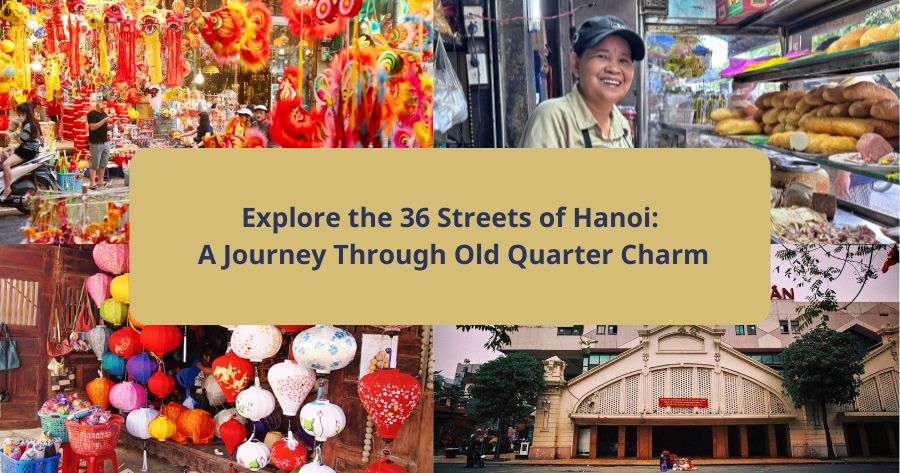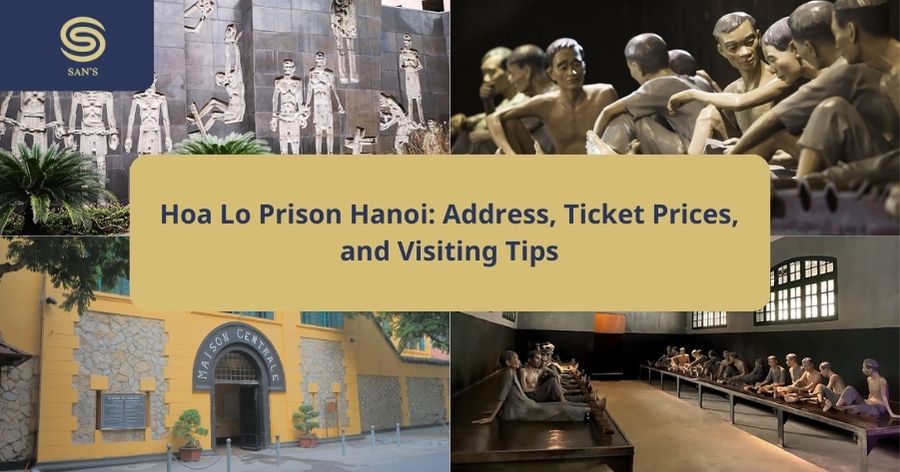Whether you’re strolling down ancient lanes, savoring local street food, or shopping for traditional handicrafts, Hanoi’s Old Quarter is a must-see destination for those wanting to experience the essence of Vietnamese culture. In this guide, Sanhotelseries will take you through the rich history, iconic streets, must-try foods, and essential tips for exploring the 36 streets of Hanoi.
Historical Overview of the 36 Streets of Hanoi
The 36 streets of Hanoi date back to the 13th century, during the time of the Ly Dynasty, when the area was home to different craft guilds. Each guild specialized in a particular trade, such as metalworking, silk weaving, or paper making. These trades gave the streets their unique names, with many still reflecting the original craft to this day. Streets such as Hang Bac (Silver Street) and Hang Gai (Silk Street) still carry the essence of the olden days, where traders gathered to sell their wares.

The Evolution of the Old Quarter
While the streets initially served as centers for specific trades, the Old Quarter has evolved into a vibrant urban hub, merging tradition with modernity. Today, you’ll find a mix of ancient houses, colonial-era architecture, modern cafes, and boutique hotels scattered throughout the district. However, the heart of the Old Quarter remains its network of narrow alleys and streets, where street vendors, motorbikes, and pedestrians coexist in a lively, chaotic dance.
The layout of the Old Quarter forms a grid-like structure, where many streets are interconnected. This maze-like arrangement is perfect for exploration, offering hidden treasures in every corner. Wander through the alleys, and you might find a traditional craft store, a family-run restaurant, or an artist’s studio.
Highlights of Hanoi’s 36 Streets
1. Hang Bac Street (Silver Street)
One of the oldest streets in Hanoi, Hang Bac Street is famous for its long-standing tradition of silver crafting. Since the 15th century, this street has been home to artisans who crafted fine jewelry, coins, and other silver ornaments. Today, visitors can still browse through family-run shops selling exquisite silver pieces, ranging from earrings and necklaces to intricately carved decorative items.
Take your time visiting some of the silver shops that have been passed down through generations. The craftsmanship is impressive, and you might even witness artisans working on their creations right in the shop.

2. Hang Ngang and Hang Dao Streets
These two streets were once bustling with silk and textile traders. Hang Ngang and Hang Dao were pivotal to Hanoi’s commercial scene in the 19th century, and while they have evolved, they remain important shopping streets in the Old Quarter.

Today, these streets are filled with fashion boutiques, fabric stores, and souvenir shops. If you’re looking for a good deal on Vietnamese textiles or modern fashion, this is the place to go. Don’t forget to haggle, it’s expected and can be a fun part of the shopping experience in Vietnam.

3. Hang Ma Street (Paper Street)
Hang Ma Street is a cultural gem, famous for its paper products used for spiritual offerings, especially during traditional festivals like the Mid-Autumn Festival and Tet (Lunar New Year). The street becomes a kaleidoscope of colors during these times, with lanterns, paper toys, and decorations filling the area.
If you’re visiting during the Mid-Autumn Festival, this street transforms into a magical world of lights and colors. It’s a fantastic spot for photography and a great place to pick up traditional souvenirs.

4. Hang Buom Street (Sail Street)
Historically known for making sails for boats, Hang Buom Street has shifted into a street food haven, offering some of the best Vietnamese street food in Hanoi. From pho to bun cha, the variety of dishes here reflects Hanoi’s rich culinary heritage.
Hang Buom is a paradise for food lovers. Make sure to try the famous bun cha (grilled pork with vermicelli) or grab a banh mi (Vietnamese sandwich) from one of the street vendors.

Traditional Crafts in the Old Quarter
Though modern shops and businesses have taken over much of the Old Quarter, the spirit of traditional crafts still lives on in the 36 streets Hanoi. Handicrafts such as embroidery, lantern making, and wood carving are still practiced, and visitors can find unique, handmade items to take home.
Handicrafts and Artisanal Trades
Many family-run workshops continue to thrive, especially in smaller streets and alleys away from the main tourist hubs. These traditional craftsmen and women maintain the skills passed down through generations, creating items like lacquerware, silk embroidery, and bamboo products.
For a truly authentic experience, visit one of these small workshops and watch the artisans at work. You can purchase handcrafted souvenirs that support local communities and keep these traditional arts alive.

Street Food in the Old Quarter
No visit to the Old Quarter is complete without sampling its famous street food. Hanoi is known for its rich culinary traditions, and the Old Quarter is the heart of it all. Be sure to try iconic dishes like pho (noodle soup), bun cha, banh cuon (steamed rice rolls), and egg coffee.

Best Places to Eat:
- Pho Thin: One of the oldest pho shops in Hanoi, famous for its rich, beefy broth.
- Banh Mi 25: A popular stop for a classic Vietnamese sandwich.
- Cafe Giang: This hidden gem is where egg coffee, a creamy and delicious Hanoi specialty, was invented.
Cultural Experiences and Local Life
Dong Xuan Market
At the heart of the Old Quarter, Dong Xuan Market is the largest wholesale market in Hanoi. It’s a bustling hub where you can find everything from clothes to electronics to fresh produce. The market is an essential part of life for locals and a fascinating place for visitors to immerse themselves in the local culture.

Vibrant Street Life
The streets of Hanoi are alive with energy, from vendors selling fruit on bicycles to street performers entertaining passersby. The mix of old and new, modern and traditional, creates a dynamic atmosphere unlike anywhere else.
Take your time walking through the narrow alleys. Wander aimlessly – sometimes the best discoveries are made when you’re not looking for them.
Tips for Exploring Hanoi’s 36 Streets
Best Time to Visit
The best time to explore the 36 streets Hanoi is early in the morning when the streets are quieter, and the temperature is cooler, or late in the afternoon when the hustle and bustle of daily life slows down.
Modes of Transportation
- Walking: The Old Quarter is best explored on foot. Walking allows you to fully appreciate the narrow alleys, hidden temples, and small cafes that you might miss otherwise.
- Cycling: For a slightly faster pace, rent a bicycle and leisurely ride through the tree-lined streets.
- Cyclo Ride: For a more traditional experience, take a cyclo ride. This three-wheeled bicycle taxi is a slower, more relaxed way to explore the Old Quarter.
Exploring the 36 streets Hanoi is a journey through time – a perfect blend of old and new, where traditional craftsmanship, vibrant street life, and mouthwatering cuisine coexist. Whether you’re looking to shop for handmade goods, savor local delicacies, or simply take in the unique charm of Hanoi’s Old Quarter, this district has something for every traveler.
Here are the “Explore Hanoi’s 36 Streets” Wishing you a delightful trip to Asian! If you visit Vietnam and the capital Hanoi, you can book a room at San Hotel for the best prices here!
Follow us on Facebook to update the latest travel information daily: San Hotel Series





